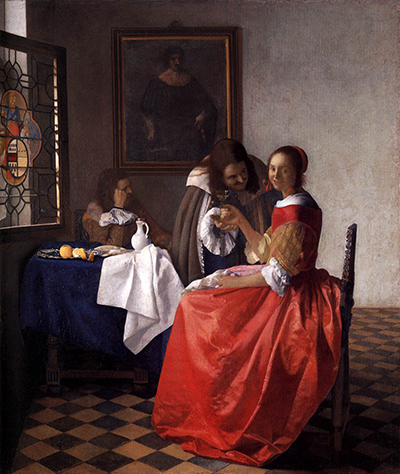The painting of The Girl With The Wine Glass illustrates a woman accompanied by two gentlemen as she holds a wine glass.
Johannes Vermeer painted the artwork in 1660 using an array of expensive oil pigments including ultramarine, vermillion, and lead tin yellow.
The smooth and rough manner used throughout the artwork adds an array of textures and surface throughout the canvas. At the time of the completion of the artwork, the artist is said to have reached his maturity in art; finding his own style and understanding.
While the artist's technique has transformed, Vermeer had remained painting in the Baroque style that was popular during the Dutch Golden Age. The exquisite detail throughout the canvas transcends the artwork through centuries gaining Vermeer popularity in recent years.
The woman is seated against the chair as she tilts her body to look at the gaze of the viewer. Her positive expression is a common characteristic of the women within Vermeer's work. The woman is aware of the situation she is in, tilting her head away from the man in front of her trying to catch her attention.
This act of the woman is meant to showcase a sense of dominance that the woman holds within the context of the situation within the artwork. The slightly transformed detail of the woman's face is believed to have been achieved by over painting.
The man right next to the woman places his hand under the woman holding the wine glass. The woman captivates the viewer as she is dressed in a bright red dress that catches the attention of the viewer. The dress holds a gold ruffled sleeve adding texture and form to the woman. The woman's hair is covered in a red strip of fabric to match her rich red dress, accentuating one another.
The sub focal point interesting to note within the painting is the similarity between the features of the two gentlemen painted. Both men are dressed in the same dark grey cloak with white ruffles, alongside similar facial features. The man towards the left side of the painting is turned away from the woman as his twin attempts to seize her attention.
The man looks disgusted as he shifts his body away in annoyance, an unusual occurrence within Vermeer's work. This interesting character within Vermeer's work is meant to add to the drama of the scene, professing a much larger emotion behind the work.
The setting of the painting is based on the same environment as Vermeer's other painting, The Wine Glass. The same woman is portrayed within the painting as she wears the same red dress and white cloak. The woman is still seated against a chair with a wine glass however is seated with her body tilted towards the viewer.
The interesting aspect to note is that another man is placed within the frame, continuing the plot from The Wine Glass. The twin of the original man seems to have seized the attention of the woman apart from the original guy.
The rest of the scenery remains to be in the same environment as the previous painting as the architecture is reflective of each other. The mosaic window remains as the focal point of the artwork as the oriental pattern showcases an array of colour and patterns. Vermeer is a classic painter who reflects his work with others continuing plots and styles.




